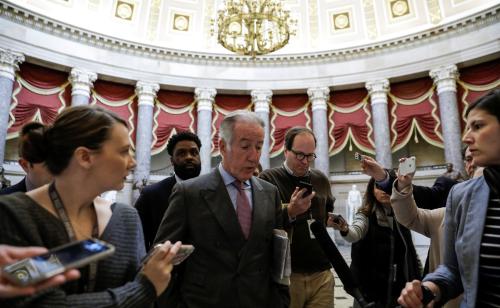When Ben Bernanke was leading the Federal Reserve through the 2007-09 global financial crisis, as we (I was his vice chairman) worked furiously on a Sunday to get a new rescue package in place before global trading began Monday, he would joke that his book would be titled “Before Asia Opens.” Well, he used another title (“The Courage to Act”), and Jay Powell can now claim the alternative title. The Fed launched a major effort before the Asian markets opened on Sunday to contain the very adverse economic effects of the efforts to damp down the spread of the coronavirus by social distancing.
On monetary policy they pulled out (almost) all the stops: Rate cuts to zero, guidance that rates will be down there for a while, longer-term securities purchases. On the provision of funding through the discount window, they loosened up on the existing facilities to lend to banks, but passed on the opportunity to revive some of the unusual, but effective, programs of the financial crisis or to innovate with a new program geared to the present crisis. They should keep these other possibilities under active consideration and have them on the shelf to roll out as needs become evident.
What the Fed did:
- Lowered its target interest rate by a full percentage point nearly to zero, and provided guidance that rates would remain at this level until “it is confident that the economy has weathered recent events and is on track to achieve its maximum employment and price stability goals.” This move followed a 50-basis-point rate cut on March 3.
- Committed to buy $700 billion of Treasury ($500 billion) and agency MBS ($200 billion) securities.
- Lowered the cost of the dollar swaps it does with foreign central banks to facilitate borrowing by foreign banks in dollars.
- Encouraged banks to borrow from the Fed’s discount window, where it extends credit to banks backed by a wide range of collateral, by reducing the penalty banks pay above market rates and extending the maturity of the loans.
- Encouraged banks to utilize intraday credit from the Federal Reserve, that is, to temporarily overdraft their Fed accounts if required. A reluctance to incur such overdrafts was identified as one factor contributing to the repo market turbulence of last September.
- Encouraged banks to utilize the buffers of liquidity and capital they have built in recent years to extend loans. In effect, the Fed is saying that, as a bank regulator, will not object to, and indeed is encouraging, drawing on liquidity and capital resources as banks meet the elevated credit needs of their household and business customers.
- Reduced banks’ reserve requirements to zero. They were already very low and served no purpose in the “ample reserves” monetary policy regime now being implemented.
What the Fed is trying to accomplish
One Fed press release was titled “Federal Reserve actions to support the flow of credit to households and businesses,” and all of their actions can be seen through this lens.
None of these actions will draw people back to work and to shopping, and they won’t stop the very considerable disruption to economic activity that is now upon us. And the Fed can’t send checks to businesses and households—that’s the job of fiscal policy. But the Fed is doing its part to keep the financial system functioning to meet the needs of the economy and in that way limit the economic damage and encourage a strong rebound when the epidemic ebbs. Keeping businesses alive so they will be around when normal activity resumes will minimize any permanent damage to the economy’s capacity to deliver goods and services. That goal will be easier to realize if households and businesses retain access to credit to ride out the rough weather.
The Fed’s actions work to limit damage and promote recovery in several ways. First, the cut in the Fed’s target rate will be helpful by making borrowing cheaper, especially with the cost of credit to many borrowers rising as investors and lenders flee from taking risk.
Next, In the US, both securities markets and banks are important sources of credit to businesses and households. The Fed can’t – by law — buy business and household debt directly in the markets. But with its securities purchases, the Fed is making sure the Treasury and mortgage-backed securities (MBS) markets are working well. The Treasury market in particular is the foundation for trading in many other securities markets in the US and around the world; if it’s disrupted, the functioning of every market will be impaired The Fed’s purchase of securities is explicitly aimed at improving the functioning of the Treasury and MBS markets, where market liquidity had been well below par in recent days. The Fed can’t buy private debt, but it is helping banks to step up their market making by encouraging the banks to use liquidity and capital buffers and by making sure the banks know that the Fed is ready and willing to provide funding to them both intraday and overnight at the discount window.
The MBS purchases will lower the cost of mortgages for households. But most households and small businesses don’t have ready access to securities markets for most of their credit needs and will be dependent on their banks for credit to tide them over. Importantly, last week the bank regulators urged banks to work with their customers who might be facing difficulties. The Fed’s actions—the flexibility on liquidity and capital requirements, the access to back up funding from the discount window–should help banks follow through.
What more could the Fed do
On monetary policy the answer is some, but not much. Since the Fed seems to have ruled out negative interest rates, the target rate is as low as it can go. And rejecting negative federal funds rates tends to put a floor under longer-term rates as well. The FOMC could instruct the New York Fed to buy more longer-term securities, and that might have some impact on the longer-term interest rates that underpin important borrowing in mortgage and corporate bond markets, but those rates are already extremely low.
Perhaps a more promising avenue would be to firm up the forward guidance about the future path of policy interest rates. The new guidance quoted above was helpful, but at some point, the Fed might want to be more specific about what it would be looking to see in the economy before it contemplated raising interest rates. Such a communication strategy could bolster the rebound as the epidemic abates by ensuring that markets don’t build in a faster policy tightening than the Fed sees as appropriate to foster a recovery to full employment and its two percent inflation target.
In the lending compartment of the Fed’s toolkit, more might be done to foster the flow of credit to households and businesses.
- The Fed could revive the auctions of discount window credit to banks it did during the global financial crisis—the Term Auction Facility. These auctions encouraged borrowing by avoiding the stigma often associated with use of the discount window, and they made liquidity directly available to the many banks that aren’t primary securities dealers and can’t participate in the repo auctions held by the NY Fed.
- The Fed could explore a credit facility similar to those being used by the European Central Bank and the Bank of England to encourage bank lending to businesses and households, especially small businesses. These facilities reward such lending with greater access to cheaper sources of funding from the central bank.
- The Fed could lend to nonbanks as it did during the crisis to address specific credit shortfalls outside the banking system. In the global financial crisis, the Fed used its authority under Section 13(3) of the Federal Reserve Act to do this. That authority still exists, but after the crisis Congress required such lending to get the approval of the Secretary of the Treasury, among other new strictures. For some varieties of nonbank lending, the Fed would need the Treasury in the first loss position because the Fed is not supposed to take credit risk. This might require congressional appropriation, although there is some speculation the Treasury could use its Exchange Stabilization Fund. These programs—for example, to support the commercial paper market, to lend to primary dealers, to support a revival of the market for securitized debt—were among the most controversial parts of the Fed’s response to the global finance crisis, but also the most successful in containing the fallout on household and business borrowers. It was encouraging to hear both Treasury Secretary Mnuchin and Fed Chair Powell express some openness to exploring them yesterday.
Yesterday, the Fed moved quickly and forcefully to use its tools to address the economic emergency created by the health emergency confronting the global economy. Now we need the Congress and the White House to step up with the fiscal policies that will help us through this very difficult, but temporary, period without lasting damage to the ability of our businesses and work force to support robust growth and employment in the years ahead.







Commentary
The Fed’s actions Sunday: All in on monetary policy; partly in on liquidity support
March 16, 2020